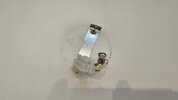I am not an electrician but have picked up enough knowledge through my work to consider myself competent enough to change a light fitting. Which is what I was doing when I came across this problem.
My kitchen extension is powered and protected by a separate RCD board to the rest of the house. It controls the lights, sockets, induction hob and electric oven. Today I was replacing a 4way GU10 spot bar with a similar LED unit. I turned off the lights, sockets and hob breakers, but left the oven and main breaker on, mainly because I didn't want to have to reset the clock on the oven.
After I had attached the new unit, I metered out the earth connection and unit chassis to check that I had a good earth connection, which I did. I decided to quickly check the live and neutral and was surprised to discover that there was a circuit between the live and the chassis and the neutral and the chassis. This was not as strong as the earth connection, but the meter was indicating both aurally and visually that some kind of circuit was being created. I assumed that there was a problem with the fitting, so disconnected it. However, when I metered it out all was good.
I then decided to meter out the bare ends of the mains cable coming out of the wall using the metal attachment screws of an adjacent 13 amp socket as an earthing point. As expected, the earth cable indicated a strong circuit was being created, but again there were indications of some sort of circuit between the live and neutral tail ends and the earthing point. I turned off the cooker breaker but this made no difference and it was only when I turned off the main breaker on the unit that the problem went away.
Do I actually have a problem that needs professional investigation, or is there something about the way RCD boards work that I don't understand? I've capped off the cable coming from the wall with chock block and LX tape until I know what is going on, and when I turned everything else back on it all worked fine.


My kitchen extension is powered and protected by a separate RCD board to the rest of the house. It controls the lights, sockets, induction hob and electric oven. Today I was replacing a 4way GU10 spot bar with a similar LED unit. I turned off the lights, sockets and hob breakers, but left the oven and main breaker on, mainly because I didn't want to have to reset the clock on the oven.
After I had attached the new unit, I metered out the earth connection and unit chassis to check that I had a good earth connection, which I did. I decided to quickly check the live and neutral and was surprised to discover that there was a circuit between the live and the chassis and the neutral and the chassis. This was not as strong as the earth connection, but the meter was indicating both aurally and visually that some kind of circuit was being created. I assumed that there was a problem with the fitting, so disconnected it. However, when I metered it out all was good.
I then decided to meter out the bare ends of the mains cable coming out of the wall using the metal attachment screws of an adjacent 13 amp socket as an earthing point. As expected, the earth cable indicated a strong circuit was being created, but again there were indications of some sort of circuit between the live and neutral tail ends and the earthing point. I turned off the cooker breaker but this made no difference and it was only when I turned off the main breaker on the unit that the problem went away.
Do I actually have a problem that needs professional investigation, or is there something about the way RCD boards work that I don't understand? I've capped off the cable coming from the wall with chock block and LX tape until I know what is going on, and when I turned everything else back on it all worked fine.


